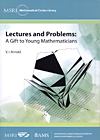- About MAA
- Membership
- MAA Publications
- Periodicals
- Blogs
- MAA Book Series
- MAA Press (an imprint of the AMS)
- MAA Notes
- MAA Reviews
- Mathematical Communication
- Information for Libraries
- Author Resources
- Advertise with MAA
- Meetings
- Competitions
- Programs
- Communities
- MAA Sections
- SIGMAA
- MAA Connect
- Students
- MAA Awards
- Awards Booklets
- Writing Awards
- Teaching Awards
- Service Awards
- Research Awards
- Lecture Awards
- Putnam Competition Individual and Team Winners
- D. E. Shaw Group AMC 8 Awards & Certificates
- Maryam Mirzakhani AMC 10 A Awards & Certificates
- Two Sigma AMC 10 B Awards & Certificates
- Jane Street AMC 12 A Awards & Certificates
- Akamai AMC 12 B Awards & Certificates
- High School Teachers
- News
You are here
Lectures and Problems: A Gift to Young Mathematicians

Publisher:
American Mathematical Society/MSRI
Publication Date:
2015
Number of Pages:
176
Format:
Paperback
Series:
MSRI Mathematical Circles Library 17
Price:
29.00
ISBN:
9781470422592
Category:
General
The Basic Library List Committee suggests that undergraduate mathematics libraries consider this book for acquisition.
[Reviewed by , on ]
Jeff Ibbotson
08/26/2016
This book is part of the Mathematical Circles Library jointly published by MSRI and the AMS. It consists of three lectures by V. I. Arnold (all written in his inimitable style) and a series of 100 of his favorite “elementary” problems. Long time readers of Arnold’s work will recognize some favorite themes appearing here and the problems are real gems. They are designed to sound trivial but require careful thought. As an example, consider the following: “Two volumes of Pushkin, the first and the second, are side-by-side on a bookshelf. The pages of each volume are 2 cm thick, and the front and back covers are each 2mm thick. A bookworm has gnawed through (perpendicular to the pages) from the first page of volume 1 to the last page of volume 2. How long is the bookworm’s track?”
The initial chapter concerns Continued Fractions. After a short introduction involving only arithmetic and lattice points, Arnold considers the geometry of the dynamical system behind such infinite entities using the “sail” surface \(xyz=1\). From there the conversation turns to spaces of matrices and graded algebras (briefly). I believe the whole thing could be followed by an average undergraduate or interested high school student.
The second chapter features a long discussion of the geometry of complex numbers, quaternions and spin number representations. Much has certainly been written about these subjects but none, I warrant, like this. As on a leisurely trip a good tour guide should point out neighboring vistas of interest, so does Arnold do the same for complex numbers. A side discussion about orientation turns into an exploration of determinants as a basis for multilinear functions in the case \(n = 2\), expansions of \(\cos(n\theta)\) and \(\sin(n\theta)\) and Chebyshev polynomials, and more. Special linear groups and normed algebras appear as well and a wonderful diagram shows exactly how the Möbius strip sits in the cross-cap construction of the projective plane.
From there things move swiftly on to elliptic curves, Riemann surfaces and the Riemann-Hurwitz formula. Hopf fibrations, spins and braids are all invoked to explain the “integer quantum Hall effect”. Phew! The discussion is never boring and the map sketched by Arnold will presumably take the student quite a bit of time to fill in the details but the essentials are all there. The appendix to the talk addresses one of Arnold’s favorite connections — the fact that the Zhukovsky transform maps the unit circle to an ellipse and thus can be used to show that complex squaring helps explain why bodies under inverse square laws orbit in ellipses. Such brilliant connections were Arnold’s forte and they are much in evidence here.
The third chapter is entitled “Euler Groups and Arithmetic of Geometric Progressions” and constitutes a dynamical systems approach to number theory that produces some very interesting results about quadratic residues. Some of this material has appeared in print before under the title Dynamics, Statistics and Projective Geometry of Galois Fields.
The final chapter is “Problems for Children 5 to 15 years old” (a euphemism if there ever was one). It introduces 79 questions that are worth the price of admission. The subject matter ranges from tricky arithmetic to mappings of Jordan-measurable domains. Many involve calculus used in service of great classical problems, others involve tangency properties of spheres and their sections, power series expansions of inverse trigonometric functions and Bernoulli numbers. The book itself offers nothing less than a tour de force of the amazing power of mathematical thought.
Oh, the answer to that first question about the bookworm is 4 mm and you might need to place two books together to see why. Or, better yet, just read Arnold’s delightful explanation of the number of smart people who have gotten this one wrong.
Jeff Ibbotson holds the Smith Teaching Chair in Mathematics at Phillips Exeter Academy.
See the table of contents in pdf format.
- Log in to post comments




